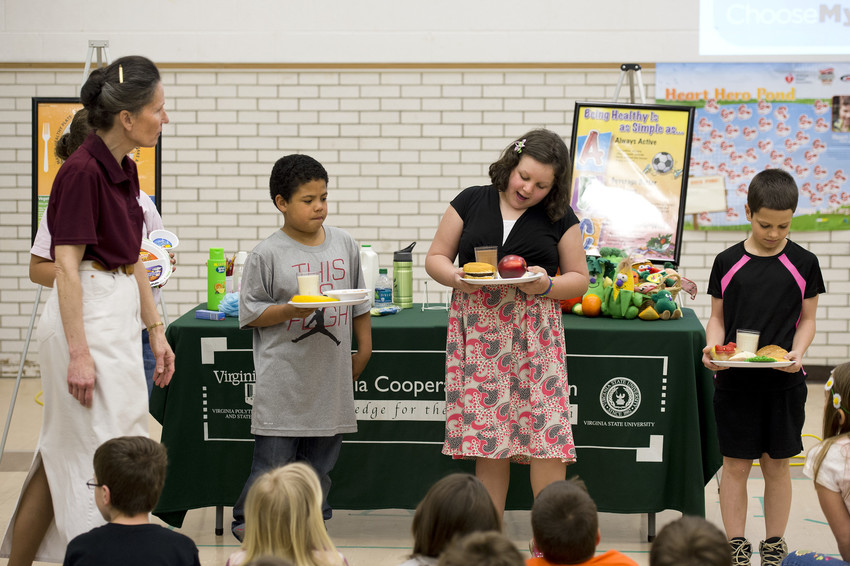Virginia Cooperative Extension

Extension work in agriculture and home economics at the university was a direct outgrowth of farm demonstration work begun by Seaman A. Knapp in Texas in 1903. Knapp was invited to Richmond in 1906 to outline his extension ideas at a meeting called by Joseph D. Eggleston Jr., then state superintendent of public instruction and later president of Virginia Tech. The decision was made to establish an extension program in Virginia, and Knapp recruited T. O. Sandy (for whom Sandy Hall is named) of Burkeville as the first demonstration agent; Knapp hired him in 1907 as the first state agent. In October 1907 Sandy added F. S. Farrar to his staff, and Farrar organized boys into “corn clubs.” When Ella Graham Agnew (for whom Agnew Hall is named) was hired in 1910, she became the first home agent—and first woman agent—in the nation. She was responsible for starting girls' “canning clubs,” forerunners of today’s 4-H Clubs.
After passage of the federal Smith‑Lever Act in 1914, the demonstration work was transferred by the General Assembly from Burkeville to the Virginia Tech campus. By then, Eggleston had become president, and he served as acting director of Agricultural Extension until Jesse M. Jones was appointed the first full-time director in July 1916. When the demonstration work was transferred to Virginia Tech in 1914, one state agent, four district agents, 50 county agents, and five special agents were working in 52 counties.
Virginia Cooperative Extension was known initially as Agricultural Extension and then Virginia Cooperative Extension Service. It was under the oversight of the College of Agriculture, with the dean of the college serving as director of extension.
In 1966 extension was moved into the newly created Extension Division (see below). At the time, its primary responsibilities, which it carried out in cooperation with the U. S. Department of Agriculture and local governments, fell in the areas of agriculture, home economics, community and resource development, public affairs, civil defense, marketing, and 4‑H programs.
In 1989 President James D. McComas moved administration of the division back to the College of Agriculture and Life Sciences and moved Continuing Education to Public Service Programs (then essentially known as Community Resource Development), which he separated from extension. He created a Cooperative Extension Deans Council, comprised of the deans of Agriculture and Life Sciences, Human Resources, Veterinary Medicine, and, later, Forestry. At the same time, the leadership title was changed, this time to director of Virginia Cooperative Extension. Public Service Programs (Community Resource Development) was separated from VCES administratively, and the extension division was renamed Virginia Cooperative Extension.
In the late 1980s and early 1990s, a push began, first with the Joint Legislative Audit and Review Committee and then within the General Assembly, to move extension programs back to their original focus on agriculture, and in 1995 extension was restructured, resulting in fewer administrators and renewed emphasis on services to farmers and more reliance on technology.
By 2008 Virginia Cooperative Extension was providing information and guidance in the areas of agriculture and natural resources, family and consumer sciences, and 4-H youth development in 107 extension offices, six 4-H educational centers, and 13 Agricultural Research and Extension Centers (ARECs). Its programs were delivered by 257 agents throughout Virginia plus 90 specialist-faculty at Virginia Tech and Virginia State University. In the winter 2009-2010, one of the ARECs became a department research lab, leaving Virginia Cooperative Extension with 12 ARECs. While administratively located in the College of Agriculture and Life Sciences, extension delivers its programs by incorporating the expertise of faculty in the College of Agriculture and Life Sciences, College of Natural Resources, Virginia-Maryland Regional College of Veterinary Medicine, and Virginia Agricultural Experiment Station, as well as the School of Agriculture, Science, and Technology at Virginia State University.
Directors: Joseph D. Eggleston Jr. (acting, 1914‑16); Jesse M. Jones (1916‑19); John R. Hutcheson (1919‑45); Leander B. Dietrick (acting, 1945; 1945‑62); William H. Daughtrey (1962‑65); William E. Skelton (1965‑76); William R. Van Dresser (1977-81); Mitchell R. Geasler (acting, 1981-82; 1982-88); James F. Johnson (acting, 1989-90; 1990-92); William A. Allen (1992-95); C. Clark Jones (interim, 1995-96; 1996-98); J. David Barrett (1999-2003); Stephen H. Umberger (2003); Judith H. Jones (interim, 2003-04); Patricia M. Sobrero (2004-05); Mark McCann (interim, 2005-06; 2006-09); Rick D. Rudd (interim, 2009-10); Alan L. Grant (2010-11); Edwin J. Jones (2011- ).
Extension Division—Enacting draft legislation proposed by Virginia Tech, the 1966 General Assembly established a university-wide Extension Division (effective July 1), combining the extension activities of the Cooperative Extension Service, General Extension Division, State Technical Services, and Continuing Education Center. Deans of the Extension Division: William E. Skelton (1966-76); William R. Van Dresser (1976-81). Title changed to Dean of Extension and Continuing Education: Mitchell R. Geasler (interim, 1981-82; 1982-88).


